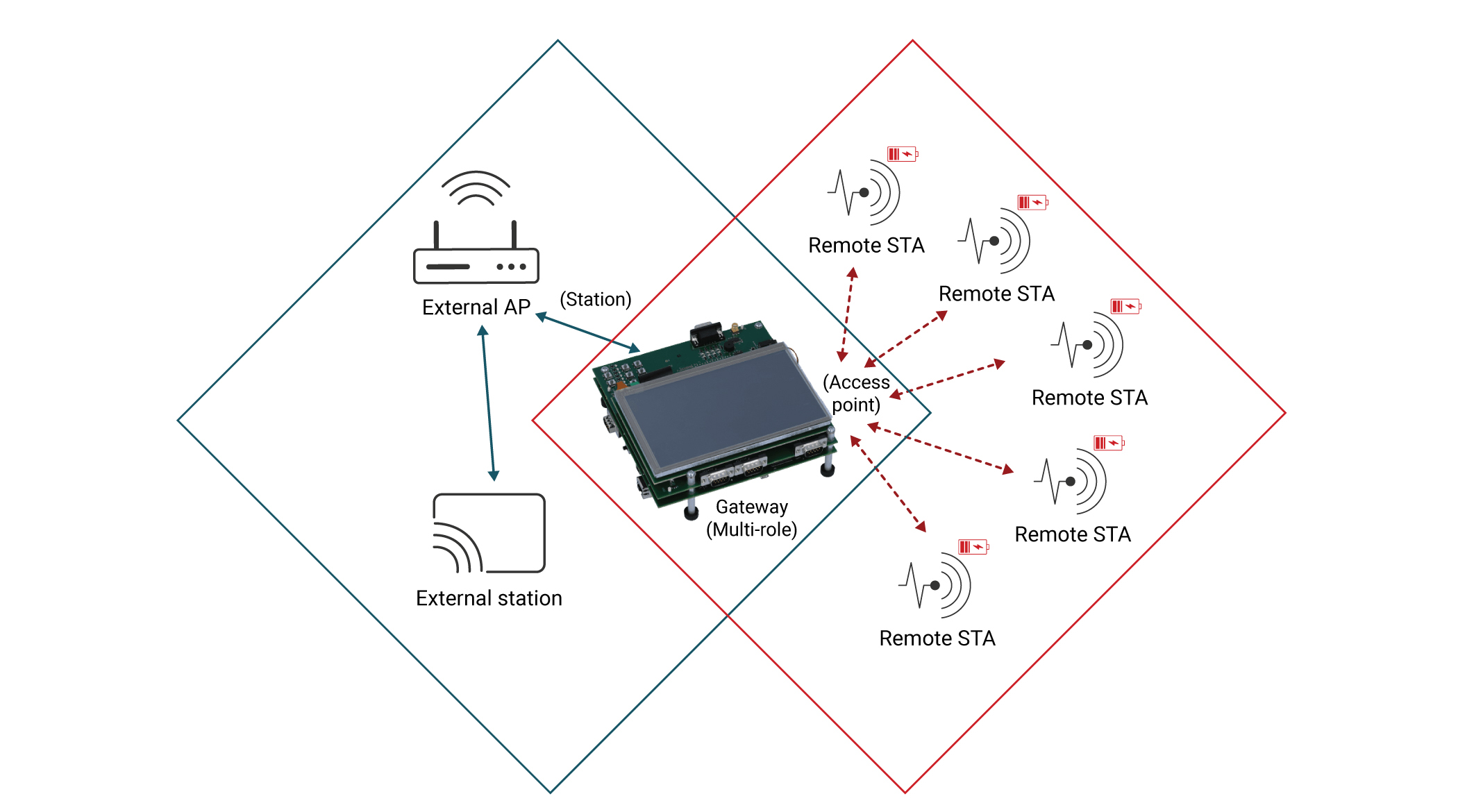SWRA733 March 2022 WL1807MOD , WL1837MOD
2.3 Experiment and Results
The test below compares the overall system efficiency (throughput) of a multi-role single-channel solution where both of STA and AP roles are running on the same channel as the external AP network versus a multi-role multi-channel solution where the AP role is running on a different band than the STA role and the external AP network. Please refer to the Appendix for the test setup details. See Figure 2-3 for a diagram of the test setup.
 Figure 2-3 Test Setup Diagram
Figure 2-3 Test Setup DiagramIn the multi-role single-channel case the traffic running in the Multi-Role as an AP network (red network) impacts the traffic running in the External AP network where the External STA is also connected (blue network) and vice versa.
In the multi-role multi-channel case, the Multi-Role as an AP is operating on a different channel (and band) compared to the External AP. This actually creates a full separation between the two networks. It means that the traffic running in the Multi-Role as an AP network (red network) does not impacts the traffic running in the External AP network (blue network) and vice versa.
The test was repeated with increasing number of remote STAs from 1 to 5. The external STA was configured to send UDP of 50 Mbps while each Remote STA was configured to send UDP of 1 Mbps. For multi-channel versus single-channel results, refer to Table 2-1
The throughput results of this comparison are summarized in Table 2-2 and Figure 2-4.
| Configuration | Blue Network | Red Network | ||||||||||
|---|---|---|---|---|---|---|---|---|---|---|---|---|
| Test Case | Multi-Role AP (Red Network) |
External AP (Blue Network) |
Bandwidth | External STA | Multi-Role STA | Remote STA#1 | Remote STA#2 | Remote STA#3 | Remote STA#4 | Remote STA#5 | ||
| Band | CH | Band | CH | |||||||||
| MRSC | 2.4 GHz | 11 | 2.4 GHz | 11 | SISO20 | 27.6 Mbps | 1 Mbps | 1.0 Mbps | ||||
| MRMC | 5 GHz | 36 | 2.4 GHz | 11 | SISO20 | 27.8 Mbps | 1 Mbps | 1.0 Mbps | ||||
| MRSC | 2.4 GHz | 11 | 2.4 GHz | 11 | SISO20 | 24.8 Mbps | 2 Mbps | 1.0 Mbps | 1.0 Mbps | |||
| MRMC | 5 GHz | 36 | 2.4 GHz | 11 | SISO20 | 27.9 Mbps | 2 Mbps | 1.0 Mbps | 1.0 Mbps | |||
| MRSC | 2.4 GHz | 11 | 2.4 GHz | 11 | SISO20 | 22.2 Mbps | 3 Mbps | 1.0 Mbps | 1.0 Mbps | 1.0 Mbps | ||
| MRMC | 5 GHz | 36 | 2.4 GHz | 11 | SISO20 | 27.5 Mbps | 3 Mbps | 1.0 Mbps | 1.0 Mbps | 1.0 Mbps | ||
| MRSC | 2.4 GHz | 11 | 2.4 GHz | 11 | SISO20 | 18.6 Mbps | 4 Mbps | 1.0 Mbps | 1.0 Mbps | 1.0 Mbps | 1.0 Mbps | |
| MRMC | 5 GHz | 36 | 2.4 GHz | 11 | SISO20 | 26.0 Mbps | 4 Mbps | 1.0 Mbps | 1.0 Mbps | 1.0 Mbps | 1.0 Mbps | |
| MRSC | 2.4 GHz | 11 | 2.4 GHz | 11 | SISO20 | 11.3 Mbps | 4.6 Mbps | 1.0 Mbps | 1.0 Mbps | 1.0 Mbps | 0.6 Mbps | 1.0 Mbps |
| MRMC | 5 GHz | 36 | 2.4 GHz | 11 | SISO20 | 24.7 Mbps | 5 Mbps | 1.0 Mbps | 1.0 Mbps | 1.0 Mbps | 1.0 Mbps | 1.0 Mbps |
| Number of remote STAs |
External STA throughput in Single-Channel |
External STA throughput Multi-Channel | Improvement |
|---|---|---|---|
| 1 | 27.6 Mbps | 27.8 Mbps | 0.7% |
| 2 | 24.8 Mbps | 27.9 Mbps | 12.5% |
| 3 | 22.2 Mbps | 27.5 Mbps | 23.87% |
| 4 | 18.6 Mbps | 26.0 Mbps | 39.78% |
| 5 | 11.3 Mbps | 24.7 Mbps | 118.58% |
 Figure 2-4 Multi-Channel Throughput Improvement
Figure 2-4 Multi-Channel Throughput ImprovementAs can be seen from the results, when each network was operating on a different channel and band (multi-channel) the overall throughput of the external STA was better for any number of remote STAs used. The throughput improvement is significantly higher when number of remote STAs in increased and can get to more than 100% with 5 remote STAs. This is directly related to the networks separation between bands which helped to avoid the interference between the Remote STAs and the External STA even though they were not connected to the same access point.